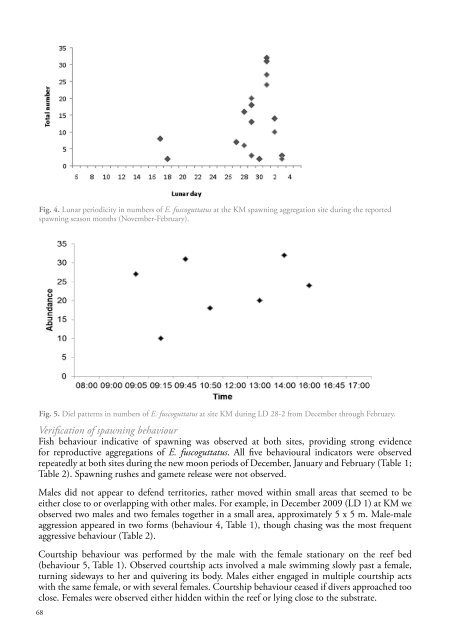WIOMSA-CORDIO spawning book Full Doc 10 oct 13.pdf
WIOMSA-CORDIO spawning book Full Doc 10 oct 13.pdf
WIOMSA-CORDIO spawning book Full Doc 10 oct 13.pdf
Create successful ePaper yourself
Turn your PDF publications into a flip-book with our unique Google optimized e-Paper software.
Fig. 4. Lunar periodicity in numbers of E. fuscoguttatus at the KM <strong>spawning</strong> aggregation site during the reported<strong>spawning</strong> season months (November-February).Fig. 5. Diel patterns in numbers of E. fuscoguttatus at site KM during LD 28-2 from December through February.Verification of <strong>spawning</strong> behaviourFish behaviour indicative of <strong>spawning</strong> was observed at both sites, providing strong evidencefor reproductive aggregations of E. fuscoguttatus. All five behavioural indicators were observedrepeatedly at both sites during the new moon periods of December, January and February (Table 1;Table 2). Spawning rushes and gamete release were not observed.Males did not appear to defend territories, rather moved within small areas that seemed to beeither close to or overlapping with other males. For example, in December 2009 (LD 1) at KM weobserved two males and two females together in a small area, approximately 5 x 5 m. Male-maleaggression appeared in two forms (behaviour 4, Table 1), though chasing was the most frequentaggressive behaviour (Table 2).Courtship behaviour was performed by the male with the female stationary on the reef bed(behaviour 5, Table 1). Observed courtship acts involved a male swimming slowly past a female,turning sideways to her and quivering its body. Males either engaged in multiple courtship actswith the same female, or with several females. Courtship behaviour ceased if divers approached tooclose. Females were observed either hidden within the reef or lying close to the substrate.68


















